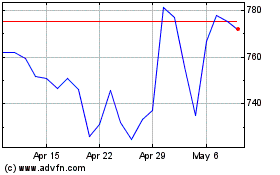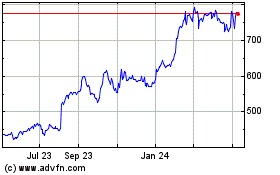By Denise Roland and Peter Loftus
Insulin prices are soaring, creating pain for patients whose
lives depend on the injectable drug -- yet most of the revenue from
the increases isn't going to the drug manufacturers, it is largely
being collected by middlemen.
The major manufacturers of insulin -- Eli Lilly & Co. of
Indianapolis, Novo Nordisk A/S of Denmark and Sanofi SA of France
-- are collecting about the same or less than they did several
years ago. The price increases reflect the growing role of
middlemen known as pharmacy-benefit managers who collect a fee
based on list prices.
This convoluted payment system for drugs in the U.S. encourages
high list prices and steep behind-the-scenes discounts. That
formula offers some bill payers lower overall costs while uninsured
patients and those with certain health plans pay more.
At the same time, higher overall costs are encouraging U.S.
health insurers and employers to make patients contribute more to
their health care. In part, their use of higher deductibles
contributes to the cost shifting to patients. Higher drug list
prices mean those patients most exposed to the price increases pay
more before their plan coverage kicks in.
"Prices for these products have increased," said Aaron
Kesselheim, an associate professor at Harvard Medical School who
has researched insulin costs. "It's also the case that there are
more patients under high-deductible health plans and who may have a
greater copay and coinsurance, and they're being exposed to a
larger share of the prices as well."
U.S. list prices for top-selling insulins -- Sanofi's Lantus,
Eli Lilly's Humalog and Novo Nordisk's Novolog -- have more than
doubled since 2011, according to data provider Truven Health
Analytics. Drugmakers are responsible for raising list prices, even
if they recently haven't gained much from the process. Lantus, the
top-selling insulin, now costs $248.51 a vial, up from $114.15 in
2011. A Sanofi spokeswoman said the company hasn't increased its
list price in nearly two years.
Net prices, or what drugmakers retain after discounts, have
stayed the same or fallen in the last two years as the
pharmaceutical companies compete to offer ever-deeper discounts to
stay on the preferred drug lists at insurers and the PBM
middlemen.
The reason drugmakers sharply raise list prices without a
corresponding increase in net price is that PBMs demand higher
rebates in exchange for including the drug on their preferred-drug
lists, said Enrique Conterno, president of Lilly's diabetes
business.
Eli Lilly has raised the list price of Humalog -- to $254.80 a
vial, more than double the 2011 price. After rebates and discounts,
Lilly on average in the U.S. collects less for its Humalog insulin
than it did in 2009, Mr. Conterno said.
PBMs get to keep a portion of the rebates off list that they
negotiate -- though they pass the rest on to clients -- and the
administrative fees that PBMs collect from manufacturers are based
on percentages of the list prices.
However, counters Steve Miller, chief medical officer of Express
Scripts Holding Co., the largest U.S. PBM, "We never tell
pharmaceutical companies we want high sticker prices. We want a low
net price."
He acknowledges that "certain patients get caught in the middle
of this, and we have got to figure out how to put guard rails
around that," such as setting a maximum pharmacy price.
For Sanofi's Lantus, the average U.S. net price fell by 17% in
2015 and is on track to fall a further 10% this year, according to
estimates by equity researchers at Sanford C. Bernstein & Co.
The firm expects the net price of Novo Nordisk's Levemir insulin to
fall 6% this year. Sanofi and Novo Nordisk have warned investors
that falling prices in the U.S. will hurt profit growth.
America's Health Insurance Plans, an industry trade group, said
drug companies control pricing, and when insulin prices rise,
"patients end up paying more -- regardless of what kind of
insurance plan they have."
Christie Tucker, a 45-year-old electrical contractor in Port
Angeles, Wash., said the bill for a six-week supply of insulin for
her son Preston has soared in the past two years.
When Preston was diagnosed, Mrs. Tucker paid $40 for a six-week
supply. But the cost jumped to more than $600 in January because,
instead of a fixed-dollar-amount copay, her insurance plan charges
30% of the pharmacy price of insulin, she said. Mrs. Tucker has
saved on some prescriptions using coupons but expects to pay $650
for the next refill.
High-deductible insurance plans are causing sticker shock for
many patients. About 23% of American workers with
employer-sponsored health plans have annual deductibles of at least
$2,000 a person, up from 7% in 2009, according to the Kaiser Family
Foundation.
Jeff Dunlop, a 41-year-old mental-health case manager in Winter
Haven, Fla., said he paid about $1,250 for a three-month supply of
Lilly's Humalog earlier this year. Mr. Dunlop, who was diagnosed
with Type 1 diabetes as a child, paid the full cost because his
family insurance plan -- offered by his wife's employer -- now has
a $4,000 annual deductible.
He can handle the cost for now but said he worries about the
future.
"There's a lot of people out there that just can't afford it,"
he said. "I'm one or two unfortunate circumstances away from being
in that boat. That's scary because I need that stuff to live.
Without it, I die."
Write to Denise Roland at Denise.Roland@wsj.com and Peter Loftus
at peter.loftus@wsj.com
(END) Dow Jones Newswires
October 07, 2016 18:01 ET (22:01 GMT)
Copyright (c) 2016 Dow Jones & Company, Inc.
Eli Lilly (NYSE:LLY)
Historical Stock Chart
From Mar 2024 to Apr 2024

Eli Lilly (NYSE:LLY)
Historical Stock Chart
From Apr 2023 to Apr 2024
